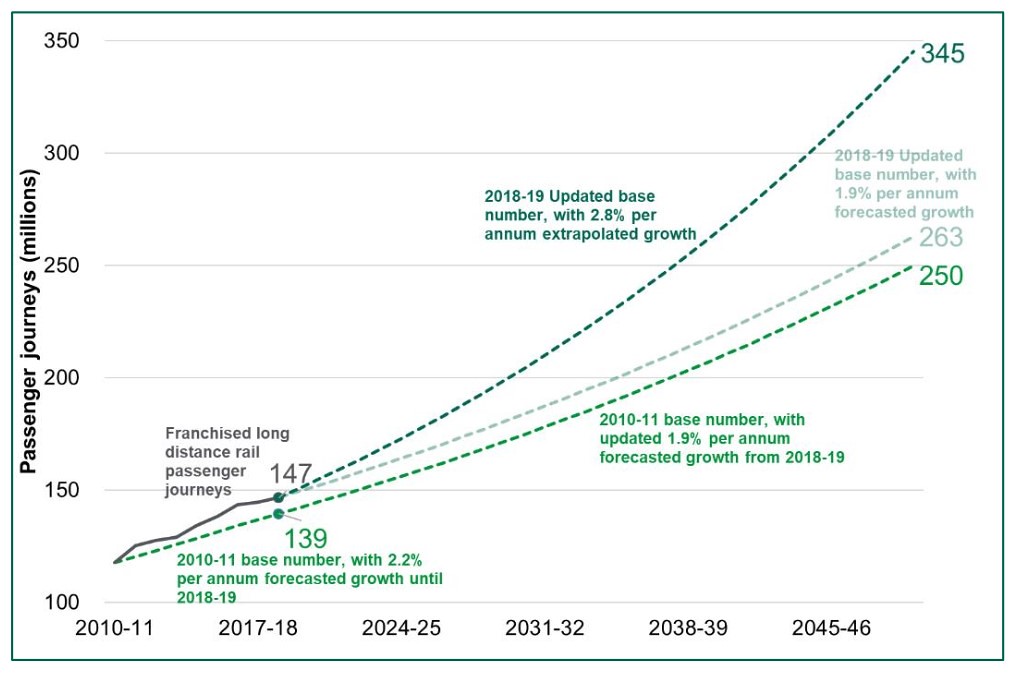High Speed 2 (HS2)
• Video Link
Background
The UK might be the birthplace of the railway, but there is only one true high-speed railway line in the UK (HS1) which runs from the Channel Tunnel to London St Pancras.
The present intercity rail network has its origins in the Victorian era but despite the lack of a TGV equivalent, carries more people than the intercity networks of France (TGV and Intercités) and Germany (ICE). There are several major trunk lines that run from London out to all corners of the UK, and HS2 looks to relieve pressure on three: primarily the West Coast Main Line (WCML), and to a lesser extent the East Coast Main Line (ECML) and Midlands Main Line (MML).
The WCML is the UK’s primary rail corridor, running from London Euston, up to Birmingham, Manchester, Liverpool, and Scotland. It is the busiest intercity route; the backbone of several commuter lines serving various cities along its route and carries some 40% of all UK rail freight. In 2008 a decade-long and incredibly disruptive upgrade to the WCML was completed, however 60% of this new capacity has already been filled.
The ECML is the second most important trunk line in the UK and has a similar traffic profile to the WCML. It runs out of London King’s Cross up to York, Newcastle and Edinburgh. Closer to London there are more intensive levels of commuter rail traffic as the southern end of the ECML forms part of the Thameslink route. There are two intercity operators on the ECML: the London North Eastern Railway and Grand Central, which carried 22.3mn and 1.5mn respectively in 2018/19.
Starting at London St Pancras, the MML runs up to Leeds via Nottingham, Derby and Leicester; East Midlands Railway provides intercity services. The London section is the primary northern route of Thameslink which is where the majority of congestion lies. The ongoing MML Upgrade Plan is increasing the number of tracks, electrification of the line north of Bedford, increasing line speeds, platform extensions and is due to be completed in 2023.
London Euston, London St Pancras and London King’s Cross are all clustered in close proximity to each other in Central London which also creates pressure on other rail services.
The Need for HS2
When the initial business case for HS2 was being drawn up in 2010-11, it was anticipated intercity passenger growth would experience annual average growth of 1.9%, which would have implied passenger growth reaching 250mn by 2049-50, which would be substantially up on current figures. In April 2020 a revised Full Business Case was published by the UK government which suggested that this has been significantly underestimated and that the rate of growth was 2.8% and that a staggering 345mn, or one million people would be using intercity rail services every day of the year.
Even looking at the shorter-term, the 2010-11 model envisioned intercity passenger volumes of 139mn by 2018-19, but the actual figure came in at 147mn. That is an additional 1mn new journeys each year on-top of the forecast growth.
 Source: Department for Transport, https://assets.publishing.service.go...-phase-one.pdf
Source: Department for Transport, https://assets.publishing.service.go...-phase-one.pdf
Taking the WCML as a case study, back in 1994, there were 17 trains per day in each direction from London to Manchester, in 2016 this had grown to 48. Intercity passenger growth on the WCML has risen from 13.2mn in 1996/97 to 39.5mn in 2018/19, an increase of 199%. Today, more people use the intercity services on the WCML than the entire Amtrak network. Based on current growth expectations, by 2033/34, 3,200 people will be standing on intercity trains departing London Euston at the PM peak. On the Friday PM peak this would rise to a staggering 5,900, with some 1,300 standing for 90 minutes or more to stations such as Warrington which is 320km from London. To put that 3,200 standing figure in perspective, that is the equivalent of 10.5x Acela Express trainsets. Factoring in the new forecasts, this situation will only be exacerbated further, and this doesn’t even factor in over-crowding on commuter services.
 Image source from Department for Transport: https://assets.publishing.service.go...tegic-case.pdf
Image source from Department for Transport: https://assets.publishing.service.go...tegic-case.pdf
It is hard not to underline just how transformative HS2 will be for the UK. HS2 creates a new high-capacity high-frequency high-speed main line that will connect eight of the ten biggest cities, revolutionise movement around the county and bring most of the UK population under one giant catchment.
Journey Times
Two thirds of the UK population will be within 120minutes of Central London upon the opening of Phase 2b. Some journey time comparisons:
- London to Birmingham (45mins, down from 82mins)
- London to Manchester (67mins, down from 127mins)
- London to Leeds (81mins, down from 131mins)
- Birmingham to Manchester (40mins, down from 88mins)
- Birmingham to Leeds (49mins, down from 118mins)
 Image source from Department for Transport: https://assets.publishing.service.go...se_1_route.pdf
Image source from Department for Transport: https://assets.publishing.service.go...se_1_route.pdf
Intercity rail capacity between the north and south will triple. That in turn will free up capacity for more intensive commuter and freight services all across the country. As an example, HS2 would enable a doubling of commuter services on the Peterborough to King’s Cross corridor on the ECML. Towns will be able to see an improved level of service to surrounding towns and cities, thereby dramatically increasing nationwide connectivity. Whole new lines and stations could open.
Hundreds of thousands of new jobs and homes will be created as HS2 forms the catalyst for new economic growth. HS2 would also aid in displacing more long-distance road traffic and further undercut domestic flights, which in turn frees up slots at the UK’s congested airports for more international flights. The line is also one of the keystones in the UK government’s efforts to make the UK a net zero carbon economy by 2050.



